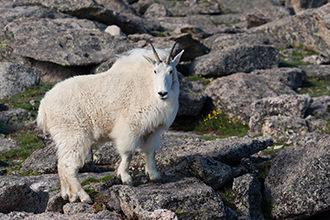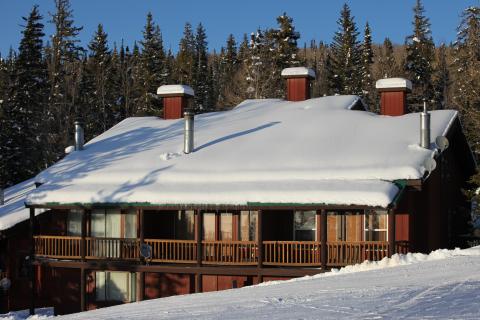If it’s wildlife you are looking for then look no further. Enjoy a day at Puffer Lake watching the Bald Eagles fish, or the bright and beautiful colors of the Mountain Blue Bird. Head to the mountain meadows of Big Flat to get a good look at majestic Elk, or bring your binoculars and head up one of the surrounding peaks to try your luck and finding a Mountain Goat. One thing is for sure, there is no shortage or wildlife around Eagle Point should you choose to find it.
| MOUNTAIN GOAT
FACT: Mountain goats molt in spring by rubbing against rocks and trees, with the adult billies shedding their extra wool first and the pregnant nannies shedding last. Their coats help them to withstand winter temperatures as low as −50 °F (−46 °C) and winds of up to 100 mph (160 km/h). Where to find them: High alpine terrain of Mount Holly, Mount Belknap, Mount Delano and Lake Peak. |
| BALD EAGLE
FACT: The bald eagle is a powerful flier, and soars thermal convection currents. It reaches speeds of 56–70 km/h (35–43 mph) when gliding and flapping, and about 48 km/h (30 mph) while carrying fish. Its dive speed is between 120–160 km/h (75–99 mph), though it seldom dives vertically. Where to find them: Around Puffer Lake, most recently the south side. |
| MOUNTAIN BLUE BIRD
FACT: The visually stunning bird weighs about 30 g (1.1 oz) with a length from 16–20 cm (6.3–7.9 in). They have light underbellies and black eyes. Adult males have thin bills and are bright turquoise-blue and somewhat lighter underneath. Adult females have duller blue wings and tail, grey breast, grey crown, throat and back. In fresh fall plumage, the female’s throat and breast are tinged with red-orange, brownish near the flank contrasting with white tail underparts. Where to find them: In and among the aspens and pine trees. |
| ELK
FACT: Elk are more than twice as heavy as mule deer and have a more reddish hue to their hair coloring, as well as large, buff colored rump patches and smaller tails. Elk cows average 225 to 241 kg (496 to 531 lb), stand 1.3 m (4.3 ft) at the shoulder, and are 2.1 m (6.9 ft) from nose to tail. Bulls are some 40% larger than cows at maturity, weighing an average of 320 to 331 kg (705 to 730 lb), standing 1.5 m (4.9 ft) at the shoulder and averaging 2.45 m (8.0 ft) in length. Where to find them: The mountain meadows of Big Flat at sunset. |
| STELLAR’S JAY
FACT: Like other jays, the Steller’s jay has numerous and variable vocalizations. One common call is a harsh SHACK-Sheck-sheck-sheck-sheck-sheck series; another skreeka! skreeka! call sounds almost exactly like an old-fashioned pump handle; yet another is a soft, breathy hoodle hoodle whistle. Its alarm call is a harsh, nasal wah. Some calls are sex-specific: females produce a rattling sound, while males make a high-pitched gleep gleep. It can mimic the vocalizations of many species of birds, other animals, and sounds of non-animal origin. It often will imitate the calls from birds of prey such as the red tailed hawk, causing other birds to seek cover and flee feeding areas. Where to find them: In and among the aspens and pine trees. |
| GREAT HORNED OWL
FACT: Adult great horned owls range in length from 43 to 64 cm (17 to 25 in), with an average of 55 cm (22 in), and possess a wingspan of 91 to 153 cm (3 ft 0 in to 5 ft 0 in), with an average of 122 cm (48 in). Females are somewhat larger than males. Great horned owls can apply at least 300 pounds per square inch (PSI) of crushing power in their talons, a PSI considerably greater than the human hand is capable of exerting. Where to find them: Well camouflaged in the forests; often roosting during the day and active at night. |
| CALLIOPE HUMMINGBIRD
FACT: During courtship, a male calliope hummingbird hovers at accelerated wingbeat frequency up to 95 flaps per second (42% higher than normal hovering), creating a loud buzzing sound, with throat feathers protruding and facing a female. Where to find them: Mountain meadows collecting nectar. |
| MULE DEER
FACT: Each spring, a buck’s antlers start to regrow almost immediately after the old antlers are shed. Shedding typically takes place in mid February, with variations occurring by locale. Where to find them: Just about anywhere, with your best chances in the morning and early evening along the grassy summer trails of Eagle Point. |
| ERMINE
FACT: The stoat (Mustela erminea), also known as the short-tailed weasel, and the name Ermine is often used for the stoat in its pure white winter coat form. Where to find them: Scurrying along the ground. |
| RED-TAILED HAWK
FACT: When soaring or flapping its wings, the Red-tailed hawk typically travels from 32 to 64 km/h (40 mph), but when diving may exceed 190 km/h (120 mph). Where to find them: Look Up! |
| BEAVER
FACT: Beavers fell trees for several reasons. They fell large mature trees, usually in strategic locations, to form the basis of a dam, but European beavers tend to use small diameter (<10 cm) trees for this purpose. Beavers fell small trees, especially young second-growth trees, for food. Where to find them: In proximity to water ways. Try the streams where the Falling Water trail (North Fork Three Creeks) intersects with Route 153. |
| PORCUPINE
FACT: Don’t pet them. Porcupines’ quills, or spines, are modified hairs coated with thick plates of keratin and embedded in the skin musclature. Quaills are released by contact or may drop out when the porcupine shakes its body. New quills grow to replace the lost ones. Porcupines were long believed to have the ability to project the quills to a considerable distance at a threat, but this has since been proven to be untrue. Where to find them: Look up into the pine trees where Full Moon and Cassidy trails brand off from each other. |
 Web Cams
Web Cams Lifts & runs
Lifts & runs














